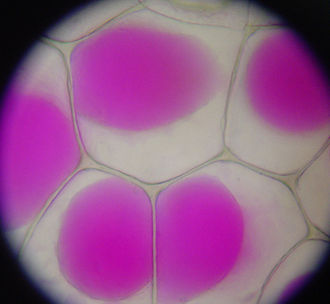Lysis: Difference between revisions
CSV import |
CSV import |
||
| Line 1: | Line 1: | ||
{{Short description|A biological process involving the breakdown of cells}} | |||
== | ==Lysis== | ||
[[File:Rhoeo_Discolor_-_Plasmolysis.jpg|thumb|right|Plasmolysis in plant cells]] | |||
'''Lysis''' is a biological process involving the disintegration or destruction of a cell by rupture of the cell wall or membrane. This process can occur naturally or be induced artificially, and it is a critical concept in various fields of biology and medicine. | |||
==Mechanisms of Lysis== | |||
Lysis can occur through several mechanisms, depending on the type of cell and the external factors involved. The primary mechanisms include: | |||
===Osmotic Lysis=== | |||
Osmotic lysis, also known as [[cytolysis]], occurs when a cell takes in too much water, causing it to swell and burst. This is often seen in [[hypotonic]] environments where the concentration of solutes outside the cell is lower than inside, leading to water influx. | |||
==Lysis | ===Enzymatic Lysis=== | ||
Enzymatic lysis involves the breakdown of the cell wall or membrane by specific enzymes. For example, [[lysozyme]] is an enzyme that can degrade the peptidoglycan layer of bacterial cell walls, leading to lysis. | |||
In [[ | ===Viral Lysis=== | ||
In viral lysis, [[bacteriophages]] or other viruses infect a host cell and replicate within it. Eventually, the host cell bursts, releasing new viral particles. This is a common method of viral propagation. | |||
==Lysis | ==Applications of Lysis== | ||
Lysis is utilized in various scientific and medical applications, including: | |||
In [[ | ===Laboratory Techniques=== | ||
In the laboratory, lysis is used to break open cells to extract [[DNA]], [[RNA]], or [[proteins]] for analysis. This is often achieved using chemical lysis buffers or mechanical disruption methods. | |||
==Lysis in | ===Medical Treatments=== | ||
Lysis is also a target in medical treatments, such as in the use of [[antibiotics]] that induce bacterial lysis or in [[cancer therapy]] where tumor cells are targeted for destruction. | |||
==Plasmolysis== | |||
[[File:Rhoeo_Discolor_-_Plasmolysis.jpg|thumb|left|Plasmolysis in plant cells]] | |||
'''Plasmolysis''' is a specific type of lysis that occurs in plant cells. It involves the contraction of the cell membrane away from the cell wall due to the loss of water through osmosis. This process is typically observed when plant cells are placed in a hypertonic solution. | |||
== | ==Related pages== | ||
* [[Apoptosis]] | |||
* [[Necrosis]] | |||
* [[Cell membrane]] | |||
* [[Bacteriophage]] | |||
[[Category:Cell biology]] | [[Category:Cell biology]] | ||
[[Category: | [[Category:Biological processes]] | ||
Latest revision as of 11:13, 15 February 2025
A biological process involving the breakdown of cells
Lysis[edit]

Lysis is a biological process involving the disintegration or destruction of a cell by rupture of the cell wall or membrane. This process can occur naturally or be induced artificially, and it is a critical concept in various fields of biology and medicine.
Mechanisms of Lysis[edit]
Lysis can occur through several mechanisms, depending on the type of cell and the external factors involved. The primary mechanisms include:
Osmotic Lysis[edit]
Osmotic lysis, also known as cytolysis, occurs when a cell takes in too much water, causing it to swell and burst. This is often seen in hypotonic environments where the concentration of solutes outside the cell is lower than inside, leading to water influx.
Enzymatic Lysis[edit]
Enzymatic lysis involves the breakdown of the cell wall or membrane by specific enzymes. For example, lysozyme is an enzyme that can degrade the peptidoglycan layer of bacterial cell walls, leading to lysis.
Viral Lysis[edit]
In viral lysis, bacteriophages or other viruses infect a host cell and replicate within it. Eventually, the host cell bursts, releasing new viral particles. This is a common method of viral propagation.
Applications of Lysis[edit]
Lysis is utilized in various scientific and medical applications, including:
Laboratory Techniques[edit]
In the laboratory, lysis is used to break open cells to extract DNA, RNA, or proteins for analysis. This is often achieved using chemical lysis buffers or mechanical disruption methods.
Medical Treatments[edit]
Lysis is also a target in medical treatments, such as in the use of antibiotics that induce bacterial lysis or in cancer therapy where tumor cells are targeted for destruction.
Plasmolysis[edit]

Plasmolysis is a specific type of lysis that occurs in plant cells. It involves the contraction of the cell membrane away from the cell wall due to the loss of water through osmosis. This process is typically observed when plant cells are placed in a hypertonic solution.